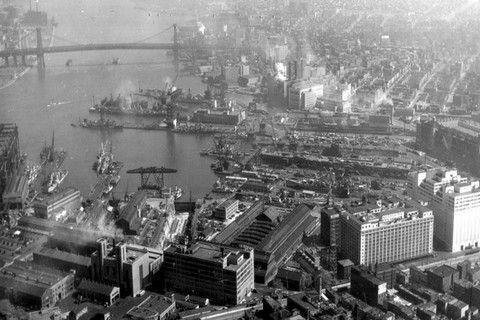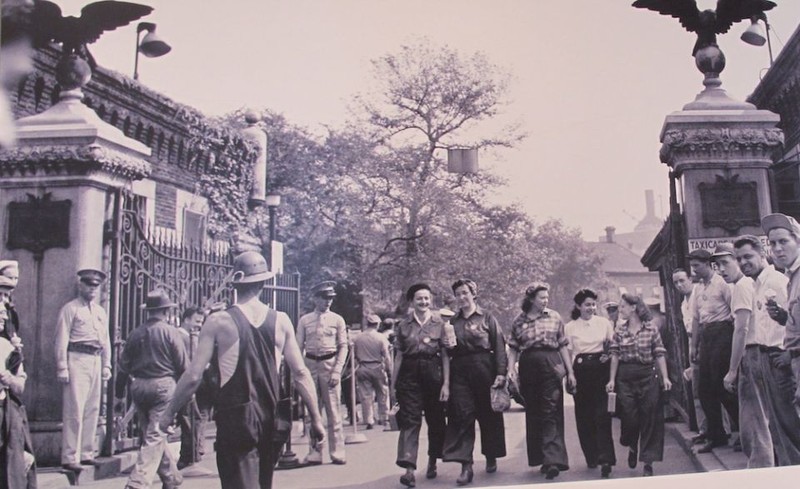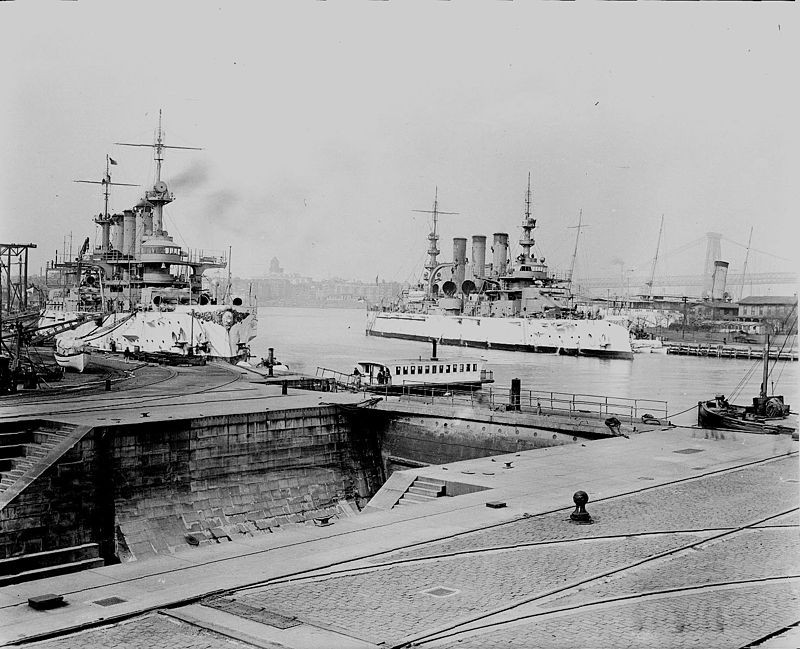Brooklyn Navy Yard
Introduction
Text-to-speech Audio
Images
The Brooklyn Navy Yard. Source: Naval Historical Center

Workers at the Brooklyn Navy Yard during WWII. Source: Brooklyn Navy Yard

USS Connecticut and Nebraska in the yard in 1909

Certificate Issued for the Closing of the Brooklyn Navy Yard. Source: Brooklyn Navy Yard

Launch of the USS Arizona in 1915 from the Brooklyn Navy Yard. The USS Arizona would later be attacked in Pearl Harbor in WWII.

Backstory and Context
Text-to-speech Audio
History of the Brooklyn Navy Yard, 1800s
Although the Brooklyn Navy Yard was designated as a naval shipyard in 1801, its history goes back to before the American Revolution. Land deeds in the Wallabout Basin have been found as far back as 1637, and the Dutch and British used the area for mercantile shipping.
During the American Revolution, just off the shore of Wallabout Bay, historical estimates show that approximately 11,500 died on British prison ships. One infamous prison ship that was moored in Wallabout Bay was the Jersey, which incarcerated American soldiers, merchants, and traders, the latter of which were imprisoned because they refused to obey the British embargo.
In 1801, under President John Adams’s orders to establish five Navy shipyards in the US, the federal government bought the land for about $40,000, and by 1806, the shipyard was officially active. The first ship built in the Yard was the USS Ohio, which launched in 1820 to help quell the Atlantic Slave Trade off the African coast. Between the 1820s and the Civil War, steam technology was greatly innovated, such as the launch of the first steam warship (the Fulton II) in 1837 and the first use of a steam-powered pile driver around 1851.
In 1852, Naval Surgeon E.R. Squibb perfected the manufacturing of ether at the Navy Yard’s Hospital, and in 1858, a Yard-built ship met a British ship halfway across the Atlantic to install the first undersea cable. That year, Queen Victoria sent the first Morse code to the US. Over the course of the Civil War, the Brooklyn Navy Yard employed nearly 6,000 men.
One of the most famous Yard-built ships in the 19th century was the USS Maine. The Maine’s launch in 1889 not only sparked the “battleship era” in US foreign policy, but also the sinking of the Maine in 1898 in Havana Harbor stood as a catalyst and battle cry (Remember the Maine!) for the Spanish-American War.
History of the Brooklyn Navy Yard, 1900s
Growth and progress at Brooklyn Navy Yard continued at an unprecedented rate around the turn of the 20th century. Theodore Roosevelt’s “Great White Fleet” was a prime example of this expansion in maritime capacity, and the Yard-built USS Connecticut stood as the fleet’s flagship vessel, marking the United States’s transition into a global power between 1907 and 1909. Brooklyn Navy Yard’s role in technological innovation also continued at this time, as seen through the first musical broadcast in 1907 on the USS Dolphin, which was docked at the Brooklyn Navy Yard during the transmission.
By the onset of WWII, the Brooklyn Navy Yard doubled in size, overtaking the adjacent produce market (at the time, the second largest in the US). Concurrently, the Yard exploded in its workforce, employing more than 70,000 people during the war and operating 24 hours a day. As men fought in the war, the Yard employed women as mechanics and technicians for the first time at the Yard.
Unfortunately, this peak at the Brooklyn Navy Yard would not last, and by 1966, Secretary of Defense Robert McNamara closed the Yard. More than 9,000 Yard employees were sent to look for work elsewhere. Yet, three years later, the Yard opened back up as an industrial plant, and by 1998, there were over 200 businesses operating at the yard, employing more than 3,000 people. In 2004, Steiner Studios, the largest and most sophisticated movie studio outside of Hollywood, opened as well, and between 2001 and 2011, the Yard experienced its largest growth since WWII.
The Brooklyn Navy Yard Today
Today, the Brooklyn Navy Yard continues to promote private manufacturing and commerce. In addition to Steiner Studios, one of the more popular buildings is BLDG 92, a museum solely dedicated to the Yard’s history and future. Since 2014, the National Register of Historic Place designated the entire Yard as a historic district, and today there are several buildings within the Yard holding landmark and historic building statuses, such as Quarters A, the Navy Yard Hospital Building, the Surgeon’s Residence, and others.1
